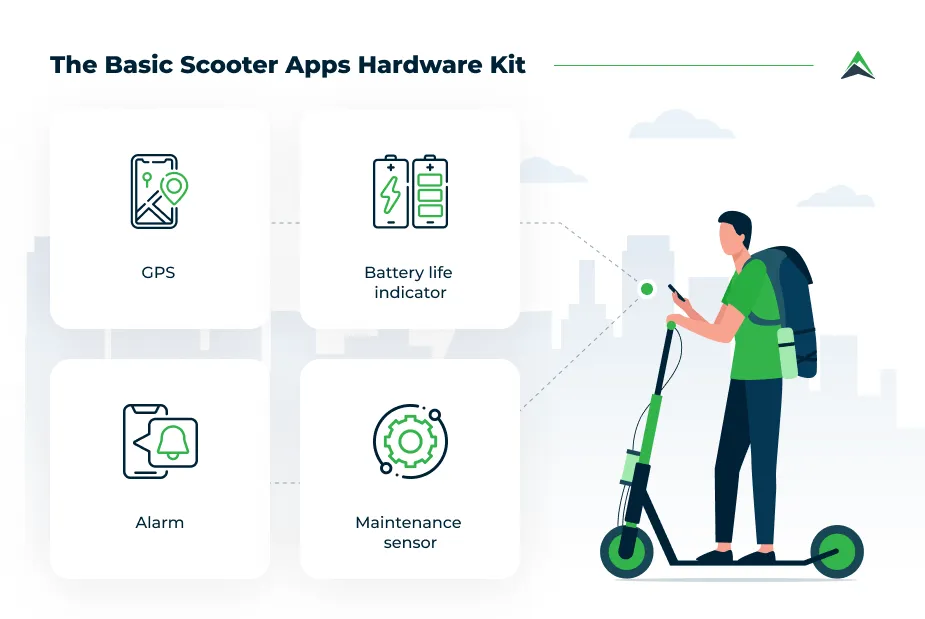In today’s environments, scooter-sharing has emerged as a go-to solution for last-mile transportation. But while the scooters themselves may grab attention on the streets, the real magic happens behind the scenes, with software.
The best Scooter Sharing Software isn’t just about helping riders unlock a vehicle. It’s the backbone that enables real-time tracking, smart routing, automated payments, fleet maintenance, user experience, and business scalability.
A Vienna case study found that using dynamic, software-driven routing for overnight scooter collection cut costs by up to 17% and reduced delays by over 50%. Real-time rerouting improved van efficiency and fleet readiness, proving how smart backend logistics drive scalable scooter-sharing operations.
Let’s dive into how the best scooter sharing systems work and why they matter.
What Is Scooter Sharing Software?
Scooter sharing software is the technology platform that powers all operational aspects of a ridesharing business. This includes:
- Fleet tracking and GPS monitoring
- User registration and KYC
- Unlock and ride management
- Payment processing
- Maintenance tracking
- Analytics and reporting
- Geo-fencing and zone management
Think of it as the central control room, managing everything from a user’s tap to unlock a ride to dispatching repair teams when scooters break down.
Key Features of the Best Scooter Sharing Software
Choosing the right solution goes beyond pretty dashboards. The best platforms are built with features that drive performance, efficiency, and customer satisfaction:
1. Real-Time Fleet Tracking
A powerful map-based dashboard shows every scooter’s location, battery status, and usage patterns. This ensures your team knows which vehicles are available, in need of charging, or require repairs, without having to inspect them physically.
2. Smart Geofencing
Define no-parking zones, high-demand areas, and restricted regions using intuitive geofencing tools. This not only improves compliance with city regulations but also reduces scooter abandonment and misuse.
3. Seamless User Experience
From sign-up to payment to ending a ride, everything needs to feel frictionless. Look for platforms that offer smooth app integration, OTP-based logins, e-wallets, and quick ride summaries.
4. Dynamic Pricing and Offers
At peak hours or during low-demand seasons, being able to adjust ride pricing dynamically is crucial. The best software includes promotional tools, subscription models, and loyalty rewards that boost both usage and revenue.
5. Predictive Maintenance and Alerts
Breakdowns in the middle of a ride? Avoid that. The top software solutions allow for real-time fault detection, auto-notifications to maintenance teams, and scheduled checkups, all helping reduce downtime.
6. White-Label Capability
Want your own branded app? A white-label solution means you can launch a scooter sharing app under your name, without having to build it from scratch.
Why the “Best” Software Matters
You might wonder: isn’t all scooter software the same? Not even close. Here’s how premium systems stand apart:
- Scalability Without Slowdowns: Whether you manage 50 or 5,000 scooters, top platforms don’t break under pressure. They’re built to handle heavy traffic, multiple zones, and diverse user volumes with consistent uptime.
- Modular Architecture: Your business will evolve, and your platform should too. Leading scooter software allows you to activate only the modules you need (e.g. payment gateway, loyalty, fleet diagnostics) and expand as you grow.
- Enterprise-Grade Security: With customer data, payments, and location tracking at stake, data security is non-negotiable. Premium platforms offer encrypted user data, secure APIs, and compliance with regional privacy laws.
- Plug-and-Play Integrations: The best software connects easily with GPS hardware, payment providers, CRMs, analytics platforms, and even IoT-based locks, saving your dev team time and cost.
- Downtime? Not an Option: Top-tier systems offer reliable uptime, redundant servers, and 24/7 tech support. Because when your app is down, you’re losing riders and revenue.
How It Powers the Business Side Too
It’s not just about offering smooth, reliable rides, it’s about building a scooter-sharing business that scales, sustains, and succeeds in a competitive market. Here’s how top-tier software contributes directly to your bottom line:
- Revenue optimization: The scooter-sharing software empowers you to earn more from every ride. With intelligent pricing algorithms, surge pricing capabilities, and loyalty programs, you can tailor your strategy to market demand. You’ll also get granular insights into usage patterns, helping you deploy scooters in high-demand areas and boost ride frequency.
- Reduced operational costs: Automation is a cost-saver. From dispatching repair teams to triggering battery swap alerts, the software reduces your need for constant human oversight. Maintenance tasks are streamlined, routing becomes smarter, and unnecessary field trips are avoided, saving time, fuel, and staffing expenses.
- Data-driven decisions: Real-time dashboards let you spot trends and act fast. Whether it’s understanding peak usage times, analyzing underperforming zones, or tracking user behavior, data guides every major decision. Want to expand to a new neighborhood or tweak a pricing model? The software backs your intuition with solid numbers.
- Regulatory compliance: As city regulations evolve, staying compliant can feel overwhelming. Built-in compliance features make it easy to generate usage reports, enforce geofencing rules, and share ride data with municipal partners. Instead of scrambling to meet policy updates, you’ll be ahead of them, with confidence.
Who Benefits Most from Scooter Sharing Software?
Scooter sharing solutions aren’t limited to tech startups; they’re powering mobility ecosystems across diverse sectors:
- Urban Mobility Startups: These are often the pioneers in micromobility, using software to launch, scale, and optimize their scooter fleets in busy city environments.
- Municipal Partnerships: Cities partner with providers that can offer real-time data sharing, geofencing, and sustainable transport options, all made possible by smart software platforms.
- University Campuses: Campuses benefit from closed-loop scooter networks for students and faculty, helping reduce congestion while promoting convenience.
- Real Estate Developers: Integrated mobility options add modern value to residential and commercial properties, enhancing tenant satisfaction and sustainability goals.
- Tourism Providers: In hotspots and scenic areas, scooter rentals boost exploration and offer an eco-friendly alternative to cars or buses.
Key Questions to Ask Before Choosing a Scooter Sharing Platform
Before you commit to a software solution, it’s important to look beyond the feature list. Ask the questions that impact your daily operations and long-term scalability:
- Can it scale with my growth? Your platform should handle a growing fleet and new city launches without performance issues or re-architecture.
- Is it intuitive for both riders and staff? A seamless rider experience and a clear, efficient dashboard for your ops team are both essential for adoption and efficiency.
- Do I need developers to maintain or customize it? Choose a solution that doesn’t trap you in constant technical dependency. Low-code or no-code configurations are a bonus.
- Will it integrate with my existing systems? Compatibility with your preferred IoT hardware, payment gateways, and CRM tools can save you major integration headaches.
- How responsive is the support team? When issues arise, like a payment bug or a lost GPS signal, you need fast, knowledgeable help. Check SLA commitments and real support reviews.
Your scooter sharing software will act as the nerve center of your operations. Make sure it’s built to grow, adapt, and support you every step of the way.
Conclusion
At the heart of every successful e-scooter business is technology that just works, quietly, efficiently, and reliably. The best scooter-sharing software brings structure to chaos, turning messy city streets into smart mobility networks.
If you’re serious about growing your rideshare brand, investing in the right software platform will help you go further, faster, and with fewer headaches.
Start with a system that’s already powering successful fleets across the world, and see how much smoother the ride can be.














